2014 Harley-Davidson SuperLow 1200T Review – First Ride

Light-duty touring for the 1200 Sportster set
News flash: Women are physically different from men. Women also constitute one of the fastest growing segments in motorcycling. Consequently, motorcycle manufacturers want to find a way for their products to appeal to more members of the matched chromosome set. Since the average height for an American woman over the age of 20 is 5’4” (a good 5.5 in. less than the average American man), designing a bike that acquits itself to a woman’s shorter stature would certainly make it more appealing – and probably sell more to that up-and-coming market.
2014 Harley-Davidson SuperLow 1200T
| Engine | 16/20 |
| Suspension/Handling | 8/15 |
| Transmission/Clutch | 8/10 |
| Brakes | 8/10 |
| Instruments/Controls | 3.75/5 |
| Ergonomics/Comfort | 8/10 |
| Appearance/Quality | 8.75/10 |
| Desirability | 8.25/10 |
| Value | 8.25/10 |
| Overall Score | 77/100 |
2014 Harley-Davidson SuperLow 1200T Preview
Harley-Davidson, like all the other OEMs, is well aware of the need for more female-focused motorcycles. The 2014 Harley-Davidson SuperLow 1200T is the most recent example of this direction. The company decided to let the intended market drive the development of the SuperLow 1200T by returning to the interviewing process they had so much success with during Project RUSHMORE. What they found was that people in the 5’1”–5’7” range didn’t properly fit touring bikes like the Heritage Softail or Switchback, and consequently, they didn’t feel comfortable riding those bigger bikes. So, the next step was to see what bike and what accessories this class of rider was building for themselves.
The result is the 2014 SuperLow 1200T. Building on the SuperLow that Harley has listed as a beginner motorcycle on its website, the next step was to modify the platform for touring duty. The list of ergonomic changes focused on the rider triangle. Maintaining a short reach to the ground is of primary importance for the intended rider. However, the 27.65-in. seat height for the 1200T is 0.25 in. taller than the SuperLow 883. The low feel of the seat was maintained by the narrowness of the seat’s leading edge, allowing for easier access to the pavement. The seat was shaped to move the rider forward an inch, reducing the reach to the handlebar, while passenger comfort was addressed with 4-in thick seat padding. To make low-speed maneuvers easier, the designers increased full lock of the handlebar by three degrees which required the turn signals be moved from the bar to below the triple clamp. Another result of the shift in signal location was that the bar could be pulled back towards the rider. The result is both a more comfortable riding position and a tighter turning radius.
The pegs, the final corner of the rider triangle, were moved forward by 3 in. compared to the SuperLow 883. And pegs weren’t used at all. Rather, a peg-floorboard hybrid, miniboard, which should offer more flexibility of foot placement than a peg but allow better access to the ground than a floorboard. The miniboards were fit with rubber insets to quell the Evolution engine’s characteristic vibration.
Asking a rider who stands six feet tall in his boots to judge the riding position of a bike designed for 5’1”–5’7” riders is an exercise in futility. Of course a 32” inseam will feel cramped and place the rider’s knees higher than his butt. So, based on the cramped position of the rider – me, in this situation – and conversations with journalists who were closer to the design target, the SuperLow 1200T has hit its ergonomics goal.
The changes to the SuperLow that put the T in the 1200 are both exactly what one would expect and somewhat surprising at the same time. The surprise comes in the form of new coil-over shocks designed specifically for the 1200T. Harley notes that the suspenders offer a 54mm stroke – a seemingly unusual use of the Metric system until you do the calculations to learn that it translates into just 2.13 in.
As is often the case, a low seat height comes at the expense of suspension travel. To try to counteract this abbreviated wheel travel, two different shocks performing two different functions were developed. The left shock is an emulsion shock with a dial-in preload adjuster which features a 0–32 click range. Changing the setting is as easy as reaching down next to the bag and turning a knob. The right shock handles rebound duties and has no adjustments. While the fork itself is unchanged, it does carry stiffer springs to handle touring loads.
Now would be the time to discuss how well the suspension worked. The weasely response would be to say that, given the limited time available and the smooth pavement encountered, the suspension didn’t do anything wrong. The non-weasely response would be that, when you can’t lean a bike over without it dragging pegs, it’s pretty hard to see how a motorcycle handles, much less stress the suspension. Just for the sake of clarity, the ground clearance was pretty sucky. Leaning motorcycles in corners is tons of fun. Do we really want to deny shorter riders the pleasure?
On the straight and narrow, a little can be gleaned about how the adjustable suspenders worked. At the beginning of the ride, Harley’s support crew asked each rider their weight and gave a recommended number of clicks to set. Surprisingly, a 170-lb. rider had the H-D certified setting of 0 clicks of preload. Who are these 5’1” riders these settings were designed for, anyway? After some time in the saddle, finding the ride a tad wallowy in the recommended setting, bumping up the preload to nine clicks made the chassis happier. Adding a passenger and gear would no doubt require other changes. Adjusting the preload was a two-finger operation that could probably have been done from the saddle – at speed – had the unseasonably cold weather not rendered most human digits barely functional.
The touring accessories are nicely appointed. The 14-in. polycarbonate windshield is adjustable for height and easily removable via four spiffy chrome clamps. No tools required here. The wind protection is good from the upper-chest down of a six foot rider, but, unfortunately, turbulent air was directed at the base of the helmet, creating lots of noise. Most likely, a rider whose body size was within the bike’s design parameters wouldn’t suffer from this. The black vinyl saddlebags, each able to hold 21 quarts, look remarkably leather-like and can be locked via a separate key. Although the bags are easily removable, the shocks wear a matt-black finish that most riders will want to leave covered. The seat matched the bags and was comfortable.
2012 Harley-Davidson Sportster SuperLow Review
Choosing the SuperLow as the base motorcycle for the 1200T meant that the Sportster’s Evolution engine would be the powerplant. The 1200 V-Twin engine has a long history with Harley and is a fairly well-known quantity. With a claimed 71 ft-lb. at 3500 rpm, the engine has enough juice to move the 599-lb. (wet) bike around smartly. Roll-on power, while not at the level of Twin Cam engines, should please most of the riders this bike is directed towards. Yes, the rubber mounts do a good job of damping the vibes, but vibration does appear at higher speeds – first in the grips at 60 mph then moving to the pegs at 65 mph and above. Higher speeds just increase the amplitude of the vibrations. The clutch pull for the Sportster was slightly heavier than that of the Twin Cam on the Low Rider we just tested, but despite the extra effort, clutch engagement was easy to modulate.
The SuperLow’s brakes wear the stainless steel lines that all bikes should have as standard equipment. ABS is a $795 option. The single 300mm disc gives a nice view of the split five-spoke aluminum wheel but requires more effort to stop quickly than a dual-disc setup. That said, the two-piston calipers offer reasonable feel. The 260mm rear disc and two-piston caliper work about right for this bike.
Seeing Harley-Davidson make an explicit move in the direction of shorter riders and women in particular is good news for motorcycling and, most likely, will be good for Harley, too. However, some strides need to be made in the ground clearance department so that these riders can enjoy the same level of fun – and safety – while out on their favorite winding road.
That said, the SuperLow 1200T, with its new suspension and nicely appointed touring accessories, looks to be a good value for the $11,799 MSRP of the Vivid Black model. The optional color, Candy Orange, bumps the price to $12,114, with the two-tone Birch White/Midnight Pearl adding another $220 to the tab. The SuperLow 1200T should be arriving in dealerships soon.
+ Highs
- Designed for female riders!
- Easily adjustable rear suspension
- Removable bags and windscreen
– Sighs
- Minimal cornering clearance
- Looks unfinished without bags
- Vibration at highway speeds

Like most of the best happenings in his life, Evans stumbled into his motojournalism career. While on his way to a planned life in academia, he applied for a job at a motorcycle magazine, thinking he’d get the opportunity to write some freelance articles. Instead, he was offered a full-time job in which he discovered he could actually get paid to ride other people’s motorcycles – and he’s never looked back. Over the 25 years he’s been in the motorcycle industry, Evans has written two books, 101 Sportbike Performance Projects and How to Modify Your Metric Cruiser, and has ridden just about every production motorcycle manufactured. Evans has a deep love of motorcycles and believes they are a force for good in the world.
More by Evans Brasfield



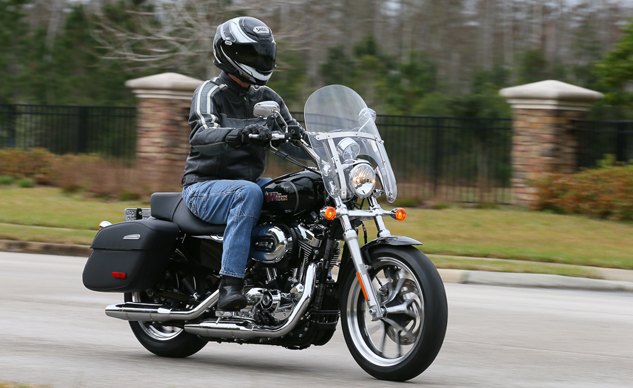
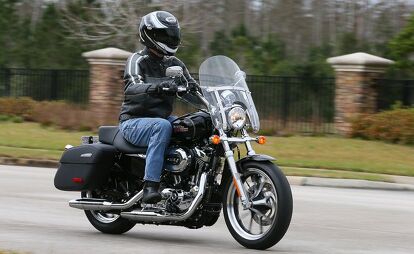




















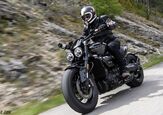

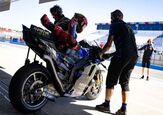













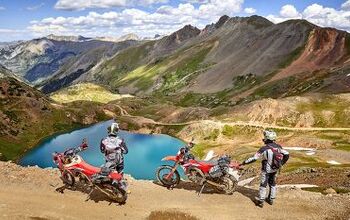




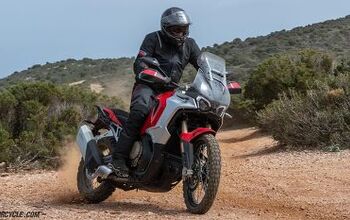
Comments
Join the conversation
The preview of this bike really caught my attention. I have never owned a Harley and I figured that this might be time to give up my K1200S and 1150 GS. I am 65 years young after all. But.............the road test here killed that thought, Vibration in the bars and pegs at 60-65 mph? Two inch travel shocks that look better covered up? And what's with the curb feelers that look about 3 inches long, don't they trust their own bike's handling?
Guess I'll keep looking for a used Buell XT.
I still lament that Harley-Davidson has dropped all the Sportsters with full length suspension, and any semblance of cornering clearance. The two that I have owned had the longer shocks and fork tubes that used to be available on bikes like the XL883R, XL1200R, XL883 (standard model), the XL1200S, the XR1200. Hey, I love the looks of the XL883N, XL1200N, the model 48 etc., but they have very little suspension travel, and they corner with a shower of sparks as hard parts touch down in the corners. A co-worked at an HD dealership I worked at followed me to work one day on a nice twisty back road route. I was 58, and he was a young kid riding a Nightster, while I had my 2006 XL883. He couldn't believe the lean angles I was getting from my "little" XL883, and he could not keep up. And the XL883 could not be leaned like a sports bike, but, could be leaned enough for this old geezer (now 60) to have fun in the twisties. And the corners is what I ride for. Sorry, Harley, but you have dropped all the best Sportsters, and since I consider the Sportsters to be the best Harley-Davidsons, I will have to look elsewhere. Not buying a new bike where the fork tubes and shocks must be replaced at added expense, to give me the fun ride I require in a motorcycle.